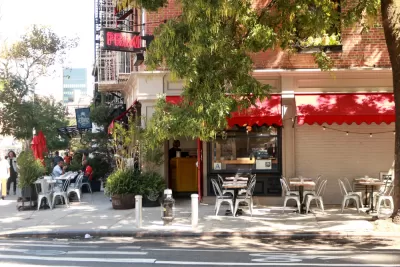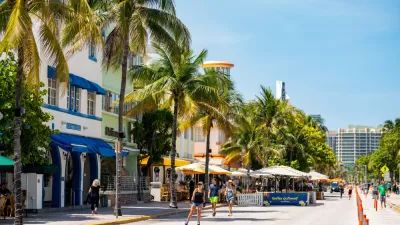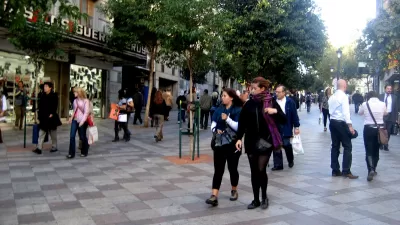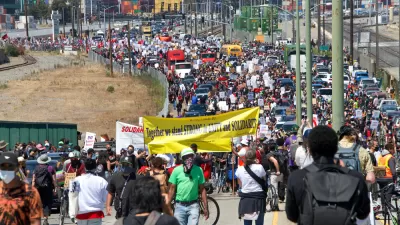Restaurants in areas designated as "slow streets" during the pandemic saw a boost in consumer interest.

As the country moves toward adjusting to a post-COVID reality, the debate over what to do with pandemic-era installations and programs such as "slow streets" and expanded outdoor dining is heating up. The urgency of the pandemic, writes Laura Bliss for Bloomberg CityLab, gave us a glimpse into "how readily urban space can be repurposed for mobility and play, and how quickly human activity can surge back when cars are removed." In a survey of 43 member cities, "the National Association of City Transportation Officials found that 22 were planning on making Covid-era traffic changes permanent, while 16 more were considering it."
Research from Yelp shows that "slow streets" and car-free zones have had a positive impact on local restaurants. Their study "measured the difference in the share of consumer interest between the sample of restaurants in each slow street zone and all restaurants across each respective city, comparing the start of the pandemic (using March 15, 2020 as a proxy), when these programs weren’t yet in place, to the various time periods when the programs were in swing." According to Yelp, "[e]ateries in car-free areas saw more consumer interest (based on the amount of views, posted photos and user reviews on Yelp listings) when their streets were strictly limited to pedestrians and cyclists."
Justin Norman, Yelp’s vice president of data science, said he hopes their research will help inform the future of car-free streets programs. "As local governments and policymakers carve out policies that enact safer streets, we hope this information adds value to that."
FULL STORY: Where Covid’s Car-Free Streets Boosted Business

Alabama: Trump Terminates Settlements for Black Communities Harmed By Raw Sewage
Trump deemed the landmark civil rights agreement “illegal DEI and environmental justice policy.”

Planetizen Federal Action Tracker
A weekly monitor of how Trump’s orders and actions are impacting planners and planning in America.

Why Should We Subsidize Public Transportation?
Many public transit agencies face financial stress due to rising costs, declining fare revenue, and declining subsidies. Transit advocates must provide a strong business case for increasing public transit funding.

Understanding Road Diets
An explainer from Momentum highlights the advantages of reducing vehicle lanes in favor of more bike, transit, and pedestrian infrastructure.

New California Law Regulates Warehouse Pollution
A new law tightens building and emissions regulations for large distribution warehouses to mitigate air pollution and traffic in surrounding communities.

Phoenix Announces Opening Date for Light Rail Extension
The South Central extension will connect South Phoenix to downtown and other major hubs starting on June 7.
Urban Design for Planners 1: Software Tools
This six-course series explores essential urban design concepts using open source software and equips planners with the tools they need to participate fully in the urban design process.
Planning for Universal Design
Learn the tools for implementing Universal Design in planning regulations.
Caltrans
Smith Gee Studio
Institute for Housing and Urban Development Studies (IHS)
City of Grandview
Harvard GSD Executive Education
Toledo-Lucas County Plan Commissions
Salt Lake City
NYU Wagner Graduate School of Public Service





























